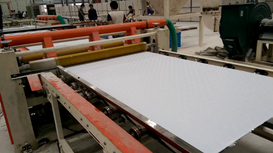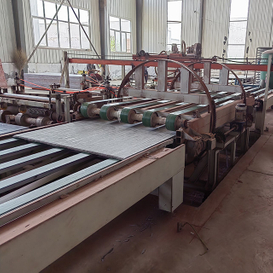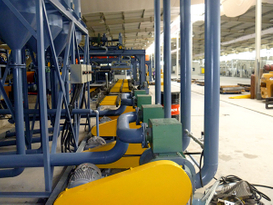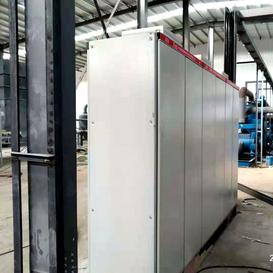Ten new building materials will change the future of architecture
In this era of rapid technological development, a variety of novel building materials are emerging, and almost all new building materials have excellent characteristics such as light weight, high strength, heat preservation, energy saving, soil saving, and decoration.
Obviously, the use of new building materials not only greatly improves the function of the house, but also makes the interior and exterior of the building more modern, meeting people's aesthetic requirements; some new building materials can significantly reduce the weight of the building, creating conditions for the promotion of light building structures. Promoting the modernization of building construction technology, greatly speeding up the construction of houses. Nowadays, the development of new materials has formed an unstoppable trend.
Although technology sometimes threatens environmental protection and ecological equity, sometimes it can also alleviate environmental crises. More and more materials engineers and designers at home and abroad are focusing on studying the relationship between nature and technology to develop more sustainable building materials.
As technology continues to develop,
What will the future of architecture look like?
Think boldly, the future can be expected.
The 10 architectural innovations listed below,
The whole building environment may be changed in the near future.
01 Graphene Aerogel
The graphene aerogel, developed by researchers from Zhejiang University in my country, is one of the lowest-density substances known on earth. It is a foam-like solid material that maintains a fixed shape even though it is almost as light as air. . Some aerogels are only 3 times denser than air, but usually aerogels are 15 times heavier than air.
You might think that aerogels are as wet as hairspray. In fact, aerogels are made by removing the liquid in the gel. Except for 90% to 99% of the air, what is left is the silica structure. Aerogel has almost no weight, but it can be stretched into thin aerogel fabrics. In construction projects, the aerogel fabric has the characteristics of "super heat insulation", and its porous structure makes it difficult for heat to pass through. Tests have shown that the thermal insulation capacity of aerogel fabric is 2 to 4 times that of traditional glass fiber or foam insulation materials. Once the price is moderate, it can be widely used in construction.
02 Green Charcoal
The concrete widely used in construction is facing many technical challenges. For example, traditional steel bars are prone to rust, resulting in a decrease in the strength and other properties of the entire composite material; in addition, concrete is also difficult to recycle, almost a disposable material. Meenal Sutaria and Shreyas More of the Indian Institute of Design and Innovation designed an alternative composite material consisting of porous carbon, loofah fiber, loam, cement and air encased in it. Each material selected has its own advantages: porous carbon is lightweight and can absorb air pollutants; organic loofah enhances the toughness of the composite material; and the soil acts as an elastic binder and maintains a stable pH. Although this material is still in the prototype development stage, it has a wide range of potential applicability in biodegradable landscape walls.
03 Nano materials
Nanotechnology is advancing materials science, which breaks through limitations that once seemed impossible. The TRY2004 pyramid super city concept has made a great contribution to the development of Tokyo, but due to the difficulty of the project, it can only be completed with the help of carbon nanotubes.
When combined with high-strength concrete, nanomaterials such as carbon nanotubes (CNT) will produce a highly stretchable material, making the building no longer need steel bars, thus speeding up the construction process. There are more possibilities. Other developments include ultra-lightweight (super strong) materials and another self-healing concrete.
04 programmable cement
Concrete production is one of the main culprits of greenhouse gas emissions. In order to further improve concrete materials, researchers at Rice University in the United States set their sights on the nano-scale field. They studied how calcium silicate hydrate (C-S-H) cement crystallized and used it to synthesize C-S-H particles with specific shapes. The researchers turned them into cubes, rectangles, prisms, dendrites, core-shells and rhombuses. Such shapes can make them more densely packed together. The team was able to control the number, size and shape of these final particles by adjusting the concentration, temperature, and duration of the original seed. This information is then mapped into a unified shape diagram that can be shared with manufacturers and builders, allowing them to design concrete with specific desired properties.
"One advantage is that because it becomes stronger, it doesn't take much to achieve the previous effect," the researchers explained: "This is because the cube particles have a better compaction effect and produce a stronger microstructure; Another advantage is that it is more durable, and its less porosity makes it more chemically isolated, so the inside of the steel bar is not easily damaged."
05 Self-healing concrete
Concrete is the most widely used building material in the world. In fact, it is the second largest consumer product on earth after water. Concrete has the advantages of low cost and wide adaptability, but it is also prone to cracking, and its compressive performance will deteriorate in extremely hot and cold environments.
In the past, the only way to repair cracked concrete was to repair it, strengthen it, or knock it off and start from scratch. But this will no longer be necessary in the future. Graduate students and chemical engineering professors at the University of Rhode Island in the United States have created a new type of "smart" concrete that can "smart" repair its own cracks. This is because micro water glass capsules are embedded in the concrete mixture. When cracks occur, the capsule ruptures and releases a gel-like healing agent, which hardens to fill the gaps and achieve self-repair.
Of course, this is not the only repair method for self-healing concrete. Other researchers have used bacteria or embedded glass capillaries or polymer microcapsules to achieve similar effects.
Extending the life of concrete can bring huge environmental benefits. Currently worldwide concrete production accounts for 5% of global carbon dioxide emissions. Smart concrete will not only make our structures safer, but also reduce greenhouse gas emissions.
06 Temperature control reflecting tiles
Temperature control reflects that ceramic tiles are a new technology and will be widely used in the future. Its beauty is that it can change different colors according to the temperature.
This temperature control reflects the ceramic tile, which is a glass decorative tile produced by a company called Moving Color. The surface of the tile is coated with a thermochromic dye, which can change with the surface temperature as if it were "alive" . At room temperature, the tile is a smooth black, but when you touch the tile or have direct light or warm water, the color of the tile transforms into rainbow-like blue, green and pink like the northern lights.
07 Carbon Nanotubes
Carbon nanotubes are currently the material with the highest specific strength that can be prepared and can be stretched more than one million times the thickness.
One nanometer (nm) is only one billionth of a meter, which is very small. The thickness of a piece of paper is 100,000 nm. The growth rate of human nails is about 1nm per second, and even human DNA strands are only 2.5nm wide. In this way, it seems impossible to construct "nano" materials. However, scientists and engineers have successfully created carbon nanotubes with a wall thickness of only 1nm by using cutting-edge technologies such as electron beam lithography.
As large particles become smaller, their surface area is constantly increasing. These carbon nanotubes have a higher specific strength than any other material on earth and can be stretched more than one million times the thickness. The light weight and high strength of carbon nanotubes allow them to be embedded in other building materials such as metals, concrete, wood, and glass to increase material density and tensile strength. Engineers even tried to add nano-sensors to building materials, so that they can be monitored before the material breaks and cracks.
08 Transparent aluminum
Transparent aluminum can require smaller internal supports to build tall glass-wall skyscrapers.
For decades, chemical engineers have coveted to develop a material that combines the strength and durability of metal with the transparency of glass. This "transparent metal" can be used to build towering glass-wall skyscrapers with very small internal supports. Military buildings can be installed with such thin and transparent metal windows to withstand the most advanced artillery fire. As early as the 1980s, scientists began experimenting with a new type of ceramic made of mixed powders of aluminum, oxygen and nitrogen. Ceramics undergo heat treatment and cooling to obtain crystal materials with high hardness. They put the mixed aluminum powder under huge pressure, heated it at 2000°C (3632 F) for several days, and finally polished it to produce a new material that is as transparent as glass and has the strength of aluminum. This space material, which is considered to be transparent aluminum or ALON, has been used in the military to produce armored windows and optical lenses.
09 CO2 Building
That's right, you heard it right. It is carbon dioxide building. At first it sounds scary. There is no way to connect carbon dioxide and building. But in fact, this is also a new technology.
What the hell is going on? It turns out that recently a group of researchers from the Massachusetts Institute of Technology in the United States successfully used genetically modified yeast to convert carbon dioxide gas into solid carbon-based building materials. The scientists said that about 30 billion metric tons of carbon dioxide are discharged into the atmosphere every year, which pollutes the environment. Using a beaker full of genetically modified yeast, they can use only 1 pound (0.5 kg) of carbon dioxide to produce 2 pounds. (1 kg) of solid carbonate. In this way, environmental pollution can be greatly reduced.
Carbon dioxide buildings built with such solid carbon-based materials are really exciting!
10 Robot group building
One of the most ingenious builders in nature is the humble termite, which uses a brain the size of sand to work with thousands of "comrades" to build a huge and complex mud structure. The termite phenomenon has attracted the attention of robotics researchers at Harvard University, because this insect does not listen to commands from the center of the ant nest. Each termite only works according to the behavior prescribed by the genetic program.
Inspired by termites, researchers from the self-organizing system research group at Harvard University formed a group of small construction robots to work. Four-wheeled robots can build brick walls by moving bricks, climbing walls, and laying bricks in open spaces. There are sensors to detect the presence of other robots and work according to the rules without interfering with each other. Just like termites, no one "controls" them, but they work together according to the program to make the design a reality.






